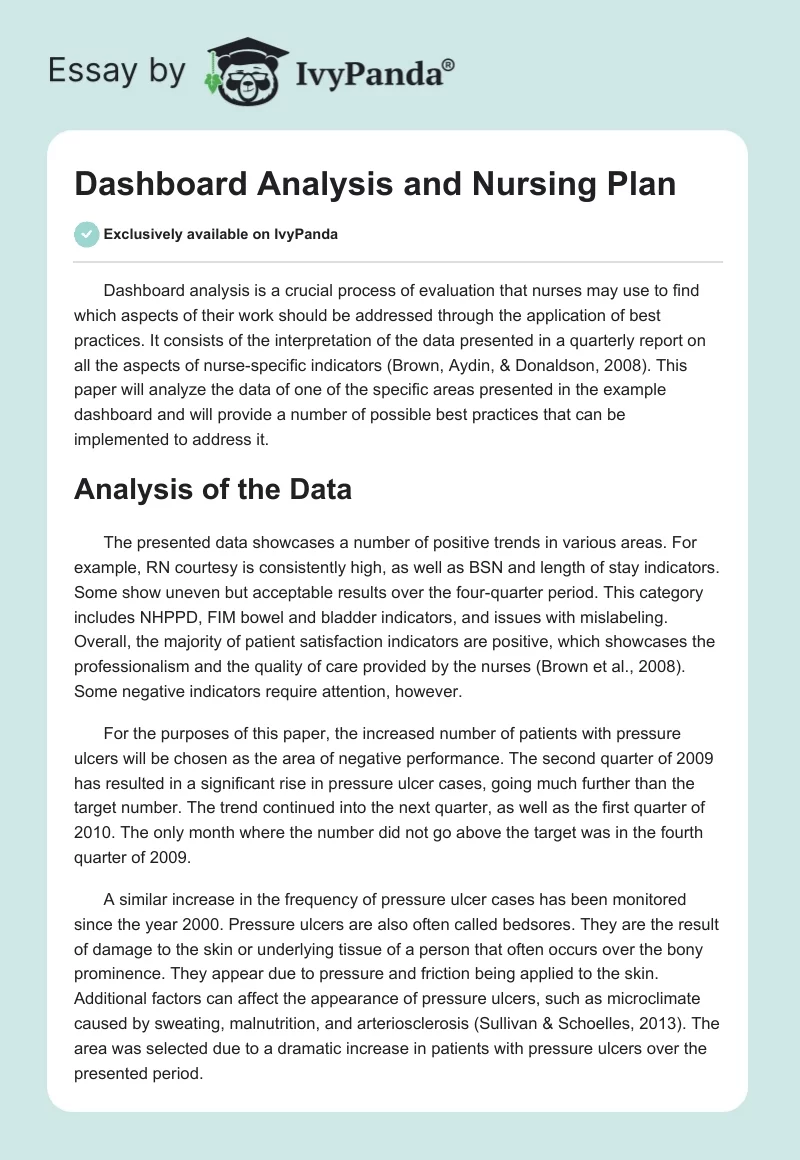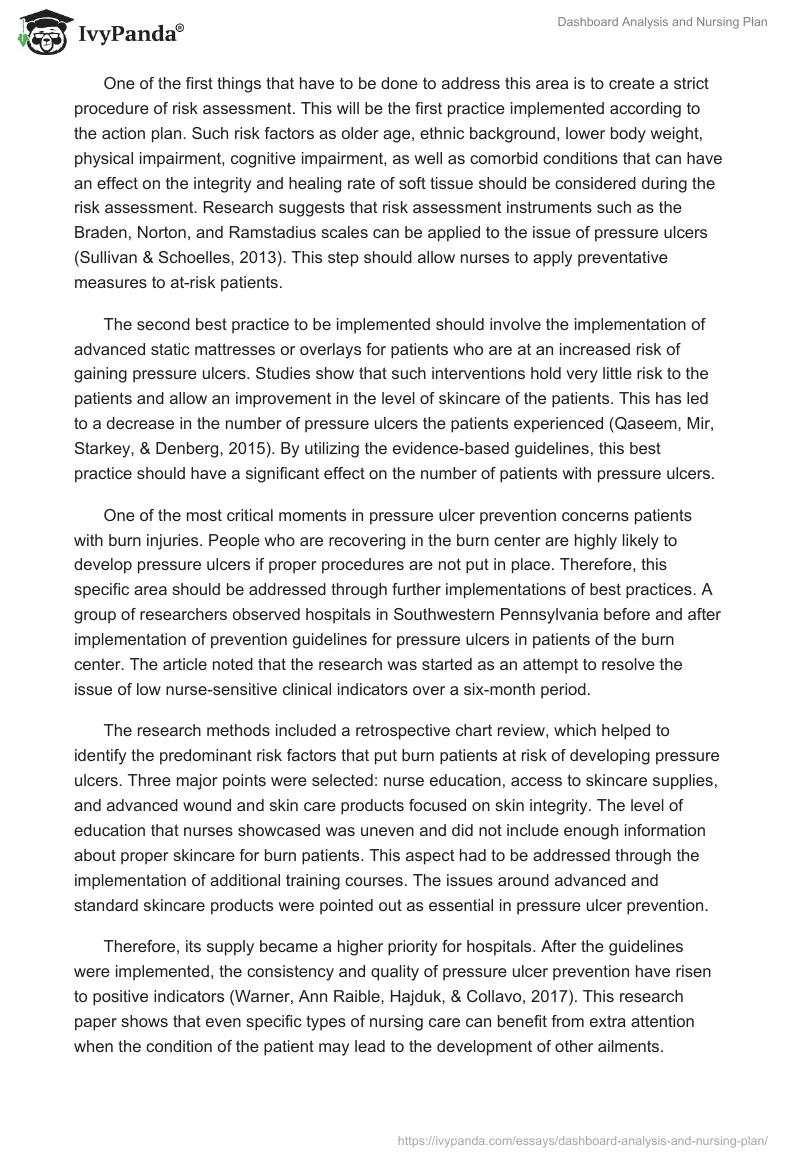Dashboard analysis is a crucial process of evaluation that nurses may use to find which aspects of their work should be addressed through the application of best practices. It consists of the interpretation of the data presented in a quarterly report on all the aspects of nurse-specific indicators (Brown, Aydin, & Donaldson, 2008). This paper will analyze the data of one of the specific areas presented in the example dashboard and will provide a number of possible best practices that can be implemented to address it.
Analysis of the Data
The presented data showcases a number of positive trends in various areas. For example, RN courtesy is consistently high, as well as BSN and length of stay indicators. Some show uneven but acceptable results over the four-quarter period. This category includes NHPPD, FIM bowel and bladder indicators, and issues with mislabeling. Overall, the majority of patient satisfaction indicators are positive, which showcases the professionalism and the quality of care provided by the nurses (Brown et al., 2008). Some negative indicators require attention, however.
For the purposes of this paper, the increased number of patients with pressure ulcers will be chosen as the area of negative performance. The second quarter of 2009 has resulted in a significant rise in pressure ulcer cases, going much further than the target number. The trend continued into the next quarter, as well as the first quarter of 2010. The only month where the number did not go above the target was in the fourth quarter of 2009.
A similar increase in the frequency of pressure ulcer cases has been monitored since the year 2000. Pressure ulcers are also often called bedsores. They are the result of damage to the skin or underlying tissue of a person that often occurs over the bony prominence. They appear due to pressure and friction being applied to the skin. Additional factors can affect the appearance of pressure ulcers, such as microclimate caused by sweating, malnutrition, and arteriosclerosis (Sullivan & Schoelles, 2013). The area was selected due to a dramatic increase in patients with pressure ulcers over the presented period.
One of the first things that have to be done to address this area is to create a strict procedure of risk assessment. This will be the first practice implemented according to the action plan. Such risk factors as older age, ethnic background, lower body weight, physical impairment, cognitive impairment, as well as comorbid conditions that can have an effect on the integrity and healing rate of soft tissue should be considered during the risk assessment. Research suggests that risk assessment instruments such as the Braden, Norton, and Ramstadius scales can be applied to the issue of pressure ulcers (Sullivan & Schoelles, 2013). This step should allow nurses to apply preventative measures to at-risk patients.
The second best practice to be implemented should involve the implementation of advanced static mattresses or overlays for patients who are at an increased risk of gaining pressure ulcers. Studies show that such interventions hold very little risk to the patients and allow an improvement in the level of skincare of the patients. This has led to a decrease in the number of pressure ulcers the patients experienced (Qaseem, Mir, Starkey, & Denberg, 2015). By utilizing the evidence-based guidelines, this best practice should have a significant effect on the number of patients with pressure ulcers.
One of the most critical moments in pressure ulcer prevention concerns patients with burn injuries. People who are recovering in the burn center are highly likely to develop pressure ulcers if proper procedures are not put in place. Therefore, this specific area should be addressed through further implementations of best practices. A group of researchers observed hospitals in Southwestern Pennsylvania before and after implementation of prevention guidelines for pressure ulcers in patients of the burn center. The article noted that the research was started as an attempt to resolve the issue of low nurse-sensitive clinical indicators over a six-month period.
The research methods included a retrospective chart review, which helped to identify the predominant risk factors that put burn patients at risk of developing pressure ulcers. Three major points were selected: nurse education, access to skincare supplies, and advanced wound and skin care products focused on skin integrity. The level of education that nurses showcased was uneven and did not include enough information about proper skincare for burn patients. This aspect had to be addressed through the implementation of additional training courses. The issues around advanced and standard skincare products were pointed out as essential in pressure ulcer prevention.
Therefore, its supply became a higher priority for hospitals. After the guidelines were implemented, the consistency and quality of pressure ulcer prevention have risen to positive indicators (Warner, Ann Raible, Hajduk, & Collavo, 2017). This research paper shows that even specific types of nursing care can benefit from extra attention when the condition of the patient may lead to the development of other ailments.
An unusual but valid approach to the issue of pressure ulcers was presented in the International Journal of Nursing Studies. A team of researchers focused their efforts on determining the frequency of various risk factors that lead to pressure ulcers. The research was done based on the data from a four-year study of military hospitals in the United States. The results of the research show that highest rated risk factors of pressure ulcer developments in the military hospitals of United States were the following in order of importance: the number of hospitalization days, serum albumin, the age of the patient, blood urea nitrogen, and the total Braden score (Raju, Su, Patrician, Loan m& McCarthy, 2015).
This study showcases two possible best practices that could be applied. The first is that the use of data mining can serve as a relatively easy way of gathering information on frequently occurring issues, and a list of risk factors that both reaffirm the existing knowledge of the issue but also add new factors to consider. Although the risk factors for the development of pressure ulcers may appear to be defined and researched, the variety of presented material on this topic suggests that a wider net of possibilities should be considered.
Lastly, the hospital should consider the implementation of a framework that could allow the nurses to focus specifically on this issue. It consists of various elements spread among four domains: leadership, staff, performance, and information IT. Aside from the previously mentioned best practices, it would include benchmarking of the outcomes, staff training, implementation of new visual tools such as posters, checklists, and others, as well as the collection of additional data through IT measures (Padula, Mishra, Makic, & Valuck, 2014). Such a framework would not only address the area of patients with pressure ulcers but also help sustain the established best practices over a significant period of time.
Conclusion
Dashboard analysis is an important process for nursing. After analyzing the data, it became clear that best practices need to be implemented to address the issue of patients with pressure ulcers. A plan based on the following practices was created: risk assessment based on the established factors as well as other possible factors, implementation of advanced static beds, utilization of specific guidelines for burn patients, and of a nursing framework. These measures should help address the presented issue.
References
Brown, D., Aydin, C., & Donaldson, N. (2008). Quartile dashboards: Translating large data sets into performance improvement priorities. Journal for Healthcare Quality, 30(6), 18-30.
Padula, W., Mishra, M., Makic, M., & Valuck, R. (2014). A framework of quality improvement interventions to implement evidence-based practices for pressure ulcer prevention. Advances in Skin & Wound Care, 27(6), 280-284.
Qaseem, A., Mir, T., Starkey, M., & Denberg, T. (2015). Risk assessment and prevention of pressure ulcers: A clinical practice guideline from the American College of Physicians. Annals of Internal Medicine, 162(5), 359-369.
Raju, D., Su, X., Patrician, P., Loan, L., & McCarthy, M. (2015). Exploring factors associated with pressure ulcers: A data mining approach. International Journal of Nursing Studies, 52(1), 102-111.
Sullivan, N., & Schoelles, K. (2013). Preventing in-facility pressure ulcers as a patient safety strategy. Annals of Internal Medicine, 158(5), 410-416.
Warner, J., Ann Raible, M., Hajduk, G., & Collavo, J. (2017). Best practices for pressure ulcer prevention in the burn center. Critical Care Nursing Quarterly, 40(1), 41-48.


